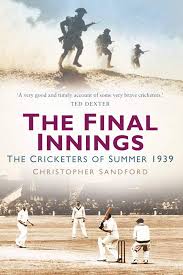The Final Innings
Martin Chandler |Published: 2019
Pages: 333
Author: Sandford, Christopher
Publisher: The History Press
Rating: 3.5 stars

At the time I expressed the view more than once that 2019 was the most momentous year of my life. Our country was deeply divided and as the year unfolded it simply became more so, troubling me a great deal. It was surprising how swiftly, just a few weeks on from last December’s general election, the atmosphere changed and once more we moved on, some of us with trepidation and some with a sense of foreboding, but at least we all thought we knew what we were moving towards.
But of course then just a few short weeks later we realised that we didn’t. A global pandemic soon turned everyone’s lives upside down for a few months, and may well do so again, and who knows if even that will see an end to it – 2020 has turned out to be just as momentous as 2019, indeed probably more so.
Perhaps in the circumstances I should have read The Final Innings before Mr Johnson’s near landslide and the arrival of Covid-19. If I had it would have put 2019 and 2020 in a rather more realistic context, and I would have realised that momentous was probably the wrong word to use. If I had been around in 1939 I could have justifiably used it then, but the challenges that faced Britain in 2019 and 2020 were not so grave as they had been eighty years earlier.
The Final Innings is a long look at the cricket season of 1939, with a brief look at the previous winter in South Africa where, 1-0 down after four Tests of a five match series, the hosts drew the fifth. That game had been due to be played to a finish, but has become know as ‘The Timeless Test’, a match that after nine days of play, one of rain and two rest days had to be called off to enable the England side to join their sea voyage home.
By the time the Englishmen arrived back the storm clouds were gathering over Europe, but there was still time to get in most of the scheduled season including three Tests against a visiting side from the Caribbean. The visitors were generally made welcome, and played some good cricket but the level of racial discrimination displayed in the country is remarkable. Even though in many ways I knew what to expect it was still genuinely shocking to learn that whilst the management of the municipal baths in Plymouth were prepared to admit the tourists, that was strictly on condition that they made a private booking, and paid for the pool to be drained and refilled after use.
There are 333 pages to The Final Innings, and it is remarkable how much of interest author Christopher Sandford manages to capture within them. It must be the case that with most of a whole season of First Class cricket to cover he did not lack material, but he shows excellent judgment in selecting which matches are worth describing in detail, and which need mentioning only in passing. And in case there is any doubt plenty of those games contained exciting cricket, and the book is a timely reminder of just what a wonderful competition a ‘proper’ County Championship is.
It is not just the cricket played in 1939 that is dealt with however. The stories of the men who played in the matches looms large, and not just those who were, tragically, to lose their lives in the conflict that was to follow. Some of the biggest names are profiled, and most of the best stories about the likes of Bill Edrich, Walter Hammond and Denis Compton are included. The retelling of these sometimes well known tales is done in a way which in no way detracts from their timeless appeal.
But the most interesting profiles are of the players just below the top level. An example is the Kent all-rounder Les Todd. I had it in my memory from somewhere that Todd could be a difficult man, but I now know exactly why. Other lesser known figures from Kent in particular are brought to life, Sandford drawing on the fund of stories that he had gathered from Godfrey Evans, whose biography he wrote almost thirty years ago.
The crisis in Europe worsened as the summer went on, but cricket got through most of its fixture list. The West Indians went home after the third Test, leaving a handful of fixtures unfulfilled, but the County Championship went almost to the end, only the last round of matches being cancelled. There was still time for a couple of notable performances. Middlesex, Jack Robertson, Edrich and Compton to the fore, scored 525 on the first day of Lord’s final peacetime fixture, and on the South Coast Yorkshire bowled Sussex out for 33, and Hedley Verity, who was to be the game’s highest profile loss in the war, took 7-9.
Neville Chamberlain declared war on 3 September 1939. The cricket season was over then, but The Final Innings is only just over two thirds of the way through. There was some cricket played during the War, but the last hundred pages are much more about social history than cricketing history and, of course, pay tribute to the men who did not survive the conflict.
When we reviewed Sandford’s not dissimilar look at the Great War, The Final Over, the reviewer tasked with that one was critical to say the least about a large number of factual inaccuracies that the book contained. The Final Innings is not entirely free from error, but there is nothing of great significance, and certainly nothing that detracts from a fine narrative.






Leave a comment